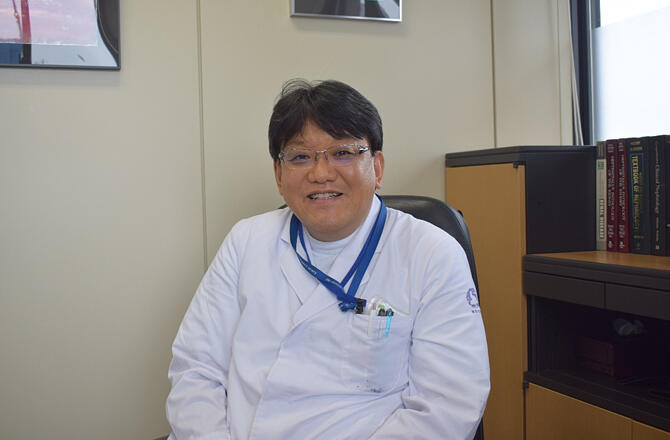What is required for the practical application of AI in medicine? This article explores an example from Tohoku University's Center for Medicinal-Hub, where data scientists and AI researchers collaborate with medical workers to develop AI for this use. This article introduces the efforts of Professor Hiroyasu Kanetaka from the Graduate School of Dentistry, Tohoku University, who is developing an AI that can diagnose whether a patient's swallowing function is declining (also known as dysphagia), just from speech data during a conversation.

Provided by Tohoku University
Pneumonia is one of the leading causes of death in Japan. Particularly in recent years as the population ages, the rate of aspiration pneumonia caused by aspiration during meals has been increasing, and it has been reported that approximately 70% of pneumonia deaths are caused by this. As such, preventative methods and measures are required to reduce risks as much as possible.
Currently, dysphagia endoscopy (also known as video endoscopy or VE) and fluoroscopic dysphagia (also known as video fluoroscopy or VF) are commonly used as diagnostic methods for dysphagia. In VE, a fiberoptic nasal scope is inserted into the throat to observe food being swallowed, while in VF the patient eats a meal containing a contrast agent such as barium while under X-ray fluoroscopy, the fluoroscopic image is observed, and the patient's swallowing movements and appropriate eating patterns are evaluated and diagnosed. Both of these methods require special equipment, not every medical institution can necessarily carry out the examinations. There are also large burdens on the patients, including cost.
According to Kanetaka, "In recent years, the number of people dying from aspiration pneumonia has been increasing. The Tohoku region has a high percentage of people who are elderly, at 28.8% in Miyagi Prefecture, over 30% in Akita Prefecture, and over 40% in some cities, towns, and villages. In some areas, it is difficult for people to commute to a core hospital, and some patients are brought to Tohoku University Hospital after their aspiration pneumonia becomes severe. We are working to develop an AI that can determine, just from regular conversation, a patient's risk of dysphagia, so that these patients can easily determine at home or elsewhere if their swallowing function is deteriorating. Eating is one of life's pleasures, so if people cannot enjoy their meals because they are afraid of aspiration, then we will not be able to build an affluent, healthy and long-lived society."
The organs used for swallowing and speaking share many common parts, such as the tongue, oral cavity, and pharynx. Speech-language training by speech-language pathologists was originally performed for patients with impaired language function due to strokes or trauma, but in recent years it has been shown to improve eating and swallowing disorders, and has also successfully been used as a rehabilitation treatment for patients who have impaired swallowing ability.
Kanetaka noted that, "Tohoku University Hospital opened the Center for Dysphagia in 2019, where members of many departments and professions involved in swallowing disorders, including otolaryngology, head and neck surgery, dentistry, and the rehabilitation department, work together to provide testing and treatment. When I talk with speech pathologists, they say that training for dysphagia is becoming more frequent these days. During these discussions, we also found that the organs that are functionally used in the oral cavity and pharynx are common between swallowing and speaking. Therefore, we thought that an articulation function assessment could be used as an alternative to swallowing function assessment."
Articulation evaluations by speech pathologists include monosyllable articulation tests, word articulation tests, speech articulation tests, and reading evaluations for long sentences, but these tests take a very long time because they require evaluation (listening) by five speech pathologists for each evaluation. It is difficult to obtain the cooperation of five speech pathologists in actual clinical settings, and there are problems such as a "lack of objectivity" and "low reliability" in the actual evaluation methods.
Kanetaka said, "Speech pathologists evaluate pronunciation and types of distortion when the patient is reading long sentences, and I want to be able to evaluate this with AI. As a first step, we confirmed that the pronunciation of healthy people can be classified by gender and age group and evaluated by AI. We are currently collecting patient data. This AI was originally developed to detect defective products based on differences in sound and evaluating a small number of examples has yielded good results."
If an AI that can diagnose swallowing dysfunction based on speech data during conversation can be developed, then, in addition to reducing the burden on the medical field, such as by reducing the working hours of medical professionals like speech therapists, doctors, and dentists, it will also be possible to identify hospitalized patients who require intensive care and will let hospitals provide optimal care to patients.
According to Kanetaka, "Oral function declines as muscle strength begins to decline with age. It has been proposed that a vicious cycle begins when a person loses the ability to eat due to oral frailty, which then leads to overall frailty. Even Parkinson's and ALS patients have shown declines in oral function before a definitive diagnosis. Many people just feel a little unwell, but if AI can screen them before they develop these diseases, then it may lead to early diagnosis and treatment. I want to put this technology into practical use as soon as possible."
The practical applications of this project are being supported in cooperation with Renascience, a bio-venture from Tohoku University.
This article has been translated by JST with permission from The Science News Ltd. (https://sci-news.co.jp/). Unauthorized reproduction of the article and photographs is prohibited.




